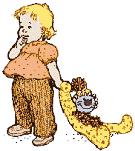 Babies cry, and they always cry for a reason. Newborns may cry when they are hungry, need changing or are craving to be held. Sometimes, they may just be having trouble
Babies cry, and they always cry for a reason. Newborns may cry when they are hungry, need changing or are craving to be held. Sometimes, they may just be having trouble adjusting to life outside the womb. But some babies cry more than others, and the wailing may signal colic or another underlying medical condition. Many physicians and child-development experts say you shouldn’t worry about spoiling your baby by responding to his cries. Instead, parents should try to determine the cause of baby’s distress. Recent studies show that babies will cry less often if their cries are promptly answered. Colic is a different matter, however, since that condition will probably run its course no matter what parents do. Generally, though, if an infant’s needs are not met, her crying escalates and she becomes more difficult to console. This hinders the parent’s ability to meet the baby’s needs and the problem becomes a vicious cycle.
adjusting to life outside the womb. But some babies cry more than others, and the wailing may signal colic or another underlying medical condition. Many physicians and child-development experts say you shouldn’t worry about spoiling your baby by responding to his cries. Instead, parents should try to determine the cause of baby’s distress. Recent studies show that babies will cry less often if their cries are promptly answered. Colic is a different matter, however, since that condition will probably run its course no matter what parents do. Generally, though, if an infant’s needs are not met, her crying escalates and she becomes more difficult to console. This hinders the parent’s ability to meet the baby’s needs and the problem becomes a vicious cycle.
Author and pediatrician William Sears says parents need to understand the language of crying to determine the cause of their child’s tears. According to Sears, the biological and hormonal changes a mother experiences when she hears her baby cry urge her to pick up and comfort her baby. It’s important to listen to your own biological cues when your baby cries, since most parents have natural instincts for calming their infant, Sears says.
her baby cry urge her to pick up and comfort her baby. It’s important to listen to your own biological cues when your baby cries, since most parents have natural instincts for calming their infant, Sears says.
Reasons for Crying
Crying has two main functions:
-
One is a message to parents that something is going on. A baby’s cry is really designed to be listened to. Babies cry in a pitch that adults are very sensitive to hearing.
-
The second function of crying is a self-regulatory one. Babies use crying as an adaptive tool that helps them regulate themselves to their environment. For example, in an airplane an infant’s crying is the body’s attempt to deal with the change of air pressure in the plane. The cry actually helps balance the pressure in the inner ear.
There are two kinds of excessive criers: those who are crying because of colic or some kind of internal discomfort and those who are just not sleeping well.
some kind of internal discomfort and those who are just not sleeping well.
Colicky babies tend to cry few hours a day, every day, for weeks. Often these episodes occur late in the day and are accompanied by babies scrunching up their faces and pulling their knees to their chests. There is no set cause or treatment for colic, several strategies for parents are often recommended:
Sometimes a change of formula is helpful.
In breastfed children, a review of the mother’s diet may be in order, since certain foods transferred through mother’s milk may not agree with the baby’s digestive system.
Most importantly, parents need to develop consistent strategies for dealing with infant crying. They need to teach infants self-soothing skills and keep them on a regulated schedule. A reliable, predictable pattern of care can be very comforting to a baby.
A more recently diagnosed condition for infants with symptoms similar to those of colic is gastro esophageal reflux. Reflux is the regurgitation of stomach acids, which causes indigestion-type symptoms in infants. This may result in inconsolable crying that appears to be due to pain.
There are two levels of treatment for babies with reflux. A more natural approach for babies with less severe cases includes elevating the head to help keep milk down or adding oatmeal to the baby’s formula to help keep the stomach acids from rising. More severe cases may need prescription-drug treatment to cut down on an infant’s stomach acid.
Older Babies Need to Comfort Themselves
During the first few months of life, parents’ main concern is comforting their infants by making sure they are well fed and cared for. But after the third month of life, in addition to nurturing, parents need to teach babies self-control and help them develop self-soothing capabilities. Babies wake up several times each night and need to be able to comfort themselves so they will go back to sleep. After the third month, parents should set up a routine with a regular bedtime.
nurturing, parents need to teach babies self-control and help them develop self-soothing capabilities. Babies wake up several times each night and need to be able to comfort themselves so they will go back to sleep. After the third month, parents should set up a routine with a regular bedtime.
-
Calm your baby with a bath and a feeding.
-
Read the baby a book and put him to bed awake, but sleepy.
-
Let the baby fuss a bit, then go in and comfort her. But do not pick her up.
Babies who learn to go to sleep independently at bedtime will learn to soothe themselves at other times and cut down on their crying.
What’s Normal and What Isn’t?
Many parents ask, ‘What is normal crying?’ Some babies need to cry for several hours during the day, just as some babies need to sleep more or eat more than others. It is time to worry when babies cry even when they are full, are fretful and look like something is hurting them.
If parents try all the steps suggested and their baby is still crying, bring the infant in for a physical exam to determine if the child is ill or has a condition like reflux.
Babies are difficult. They are not able to give clear signals of what they want. And it doesn’t help that parents are bombarded with conflicting advice on how to deal with crying babies.
Listening and responding to a baby’s cries are skills that will be perfected as parent and baby get to know each other better. What’s important, he says, is letting your infant know you are there for him when he needs you, while also giving him the chance to learn how to soothe himself.
Source: The PDR Family Guide, Encyclopedia of Medical Care (1997)